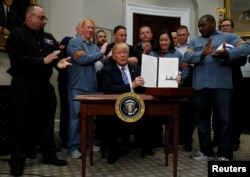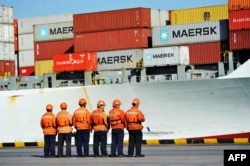Is this what a trade war looks like?
The Trump administration and China's leadership have threatened to impose tariffs on $50 billion of each other's goods. Trump has proposed imposing duties on $400 billion more if China doesn't further open its markets to U.S. companies and reduce its trade surplus with the United States. China, in turn, says it will retaliate.
In recent years, tariffs had been losing favor as a tool of national trade policy. They were largely a relic of 19th and early 20th centuries that most experts viewed as mutually harmful to all nations involved. But President Donald Trump has restored tariffs to a prominent place in his self-described America First approach.
Trump enraged U.S. allies Canada, Mexico and the European Union earlier this month by slapping tariffs on their steel and aluminum shipments to the United States. The tariffs have been in place on most other countries since March.
Trump has also asked the U.S. Commerce Department to look into imposing tariffs on imported cars, trucks and auto parts, arguing that they pose a threat to U.S. national security.
Here is a look at what tariffs are, how they work, how they've been used in the past and what to expect now.
Are we in a trade war?
Economists have no set definition of a trade war. But with the world's two largest economies aggressively threatening each other with punishing tariffs, such a war appears perilously close. All told, the White House has threatened to hit $450 billion of China's exports to the U.S. with punitive tariffs. That's equivalent to 90 percent of the goods that China shipped to the United States last year.
It's not uncommon for countries — even close allies — to fight over trade in specific products. The United States and Canada, for example, have squabbled for decades over softwood lumber.
But the U.S. and China are fighting over much broader issues, such as China's requirements that American companies share advanced technology to access China's market, and the overall trade deficit the U.S. has with China. So far, neither side has shown any sign of bending.
What are tariffs?
Tariffs are a tax on imports. They're typically charged as a percentage of the transaction price that a buyer pays a foreign seller. Say an American retailer buys 100 garden umbrellas from China for $5 apiece, or $500. The U.S. tariff rate for the umbrellas is 6.5 percent. The retailer would have to pay a $32.50 tariff on the shipment, raising the total price from $500 to $532.50.
In the United States, tariffs — also called duties or levies — are collected by Customs and Border Protection agents at 328 ports of entry across the country. Proceeds go to the Treasury. The tariff rates are published by the U.S. International Trade Commission in the Harmonized Tariff Schedule, which lists U.S. tariffs on everything from dried plantains (1.4 percent) to parachutes (3 percent).
Sometimes, the U.S. will impose additional duties on foreign imports that it determines are being sold at unfairly low prices or are being supported by foreign government subsidies.
Do other countries have higher tariffs than the United States?
Most key U.S. trading partners do not have significantly higher average tariffs. According to an analysis by Greg Daco at Oxford Economics, U.S. tariffs, adjusted for trade volumes, on goods from around the world average 2.4 percent, above Japan's 2 percent and just below the 3 percent for the European Union and 3.1 percent for Canada.
The comparable figures for Mexico and China are higher: Both have higher duties that top 4 percent.
Trump has complained about the 270 percent duty that Canada imposes on dairy products. But the United States has its own ultra-high tariffs — 168 percent on peanuts and 350 percent on tobacco.
What are tariffs supposed to accomplish?
Two things: Raise government revenue and protect domestic industries from foreign competition. Before the establishment of the federal income tax in 1913, tariffs were a big money raiser for the U.S. government. From 1790 to 1860, for example, they produced 90 percent of federal revenue, according to Clashing Over Commerce: A History of US Trade Policy by Douglas Irwin, an economist at Dartmouth College. By contrast, last year tariffs accounted for only about 1 percent of federal revenue.
In the fiscal year that ended Sept. 30, the U.S. government collected $34.6 billion in customs duties and fees. The White House Office of Management and Budget expects tariffs to fetch $40.4 billion this year.
Those tariffs are meant to increase the price of imports or to punish foreign countries for committing unfair trade practices, like subsidizing their exporters and dumping their products at unfairly low prices. Tariffs discourage imports by making them more expensive. They also reduce competitive pressure on domestic competitors and can allow them to raise prices.
Tariffs fell out of favor as global trade expanded after World War II.
The formation of the World Trade Organization and the advent of trade deals like the North American Free Trade Agreement among the U.S., Mexico and Canada reduced tariffs or eliminated them altogether.
Why are tariffs making a comeback?
After years of trade agreements that bound the countries of the world more closely and erased restrictions on trade, a populist backlash has grown against globalization. This was evident in Trump's 2016 election and the British vote that year to leave the European Union — both surprise setbacks for the free-trade establishment.
Critics note that big corporations in rich countries exploited looser rules to move factories to China and other low-wage countries, then shipped goods back to their wealthy home countries while paying low tariffs or none at all. Since China joined the WTO in 2001, the United States has shed 3.1 million factory jobs, though many economists attribute much of that loss not to trade but to robots and other technologies that replace human workers.
Trump campaigned on a pledge to rewrite trade agreements and crack down on China, Mexico and other countries. He blames what he calls their abusive trade policies for America's persistent trade deficits — $566 billion last year. Most economists, by contrast, say the deficit simply reflects the reality that the United States spends more than it saves. By imposing tariffs, he is beginning to turn his hard-line campaign rhetoric into action.
Are tariffs a wise policy?
Most economists — Trump's trade adviser Peter Navarro is a notable exception — say no. The tariffs drive up the cost of imports. And by reducing competitive pressure, they give U.S. producers leeway to raise their prices, too. That's good for those producers — but bad for almost everyone else.
Rising costs especially hurt consumers and companies that rely on imported components. Some U.S. companies that buy steel are complaining that Trump's tariffs put them at a competitive disadvantage. Their foreign rivals can buy steel more cheaply and offer their products at lower prices.
More broadly, economists say trade restrictions make the economy less efficient. Facing less competition from abroad, domestic companies lose the incentive to increase efficiency or to focus on what they do best.







